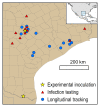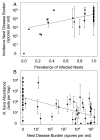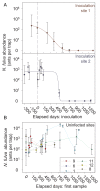Pathogen-mediated natural and manipulated population collapse in an invasive social insect
- PMID: 35344435
- PMCID: PMC9168452
- DOI: 10.1073/pnas.2114558119
Pathogen-mediated natural and manipulated population collapse in an invasive social insect
Abstract
SignificanceInvasive social insects are among the most damaging of invasive organisms and have proved universally intractable to biological control. Despite this, populations of some invasive social insects collapse from unknown causes. We report long-term studies demonstrating that infection by a microsporidian pathogen causes populations of a globally significant invasive ant to collapse to local extinction, providing a mechanistic understanding of a pervasive phenomenon in biological invasions: the collapse of established populations from endogenous factors. We apply this knowledge and successfully eliminate two large, introduced populations of these ants. More broadly, microsporidian pathogens should be evaluated for control of other supercolonial invasive social insects. Diagnosing the cause of unanticipated population collapse in invasive organisms can lead to applied solutions.
Keywords: Nylanderia fulva; biological control; invasive ant; microsporidia; natural enemy.
Conflict of interest statement
The authors declare no competing interest.
Figures







Similar articles
-
Myrmecomorba nylanderiae gen. et sp. nov., a microsporidian parasite of the tawny crazy ant Nylanderia fulva.J Invertebr Pathol. 2015 Jul;129:45-56. doi: 10.1016/j.jip.2015.05.012. Epub 2015 May 29. J Invertebr Pathol. 2015. PMID: 26031565
-
Supercolonial structure of invasive populations of the tawny crazy ant Nylanderia fulva in the US.BMC Evol Biol. 2018 Dec 29;18(1):209. doi: 10.1186/s12862-018-1336-5. BMC Evol Biol. 2018. PMID: 30594137 Free PMC article.
-
First Record of Invasive Tawny Crazy Ant Nylanderia fulva (Mayr) (Hymenoptera: Formicidae) in Continental Ecuador and Notes on Its Ecology in Sugarcane Crops.Neotrop Entomol. 2020 Feb;49(1):147-150. doi: 10.1007/s13744-019-00709-1. Epub 2019 Aug 14. Neotrop Entomol. 2020. PMID: 31414400
-
Pathogens and disease defense of invasive ants.Curr Opin Insect Sci. 2019 Jun;33:63-68. doi: 10.1016/j.cois.2019.03.011. Epub 2019 Apr 5. Curr Opin Insect Sci. 2019. PMID: 31358197 Review.
-
Impact of invasive ant species on native fauna across similar habitats under global environmental changes.Environ Sci Pollut Res Int. 2021 Oct;28(39):54362-54382. doi: 10.1007/s11356-021-15961-5. Epub 2021 Aug 17. Environ Sci Pollut Res Int. 2021. PMID: 34405331 Review.
Cited by
-
Insect immunity in the Anthropocene.Biol Rev Camb Philos Soc. 2025 Apr;100(2):698-723. doi: 10.1111/brv.13158. Epub 2024 Nov 5. Biol Rev Camb Philos Soc. 2025. PMID: 39500735 Free PMC article. Review.
-
Five novel RNA viruses of the invasive big-headed ant (Pheidole megacephala).Arch Virol. 2025 Aug 6;170(9):190. doi: 10.1007/s00705-025-06375-6. Arch Virol. 2025. PMID: 40767908 Free PMC article.
-
Marauding crazy ants come to grief when a fungus comes to call.Nature. 2022 Apr;604(7904):11. doi: 10.1038/d41586-022-00888-9. Nature. 2022. PMID: 35352047 No abstract available.
-
Disease from leaves to landscapes: viral hotspots are determined by spatial arrangement and phytochemistry of host plants in specialist caterpillars.Proc Biol Sci. 2025 Feb;292(2041):20242753. doi: 10.1098/rspb.2024.2753. Epub 2025 Feb 26. Proc Biol Sci. 2025. PMID: 39999890
References
-
- Webb S. D., Ecogeography and the great American interchange. Paleobiology 17, 266–280 (1991).
-
- Vitousek P. M., Antonio C. M., Loope L. L., Westbrooks R., Biological invasions as global environmental change. Am. Sci. 84, 218–228 (1996).
-
- Sakai A. K., et al. , The population biology of invasive species. Annu. Rev. Ecol. Syst. 32, 305–332 (2001).
-
- Iacarella J. C., Mankiewicz P. S., Ricciardi A., Negative competitive effects of invasive plants change with time since invasion. Ecosphere 6, 1–14 (2015).
-
- Morrison L. W., Long-term impacts of an arthropod-community invasion by the imported fire ant, Solenopsis invicta. Ecology 83, 2337–2345 (2002).
MeSH terms
Substances
LinkOut - more resources
Full Text Sources

